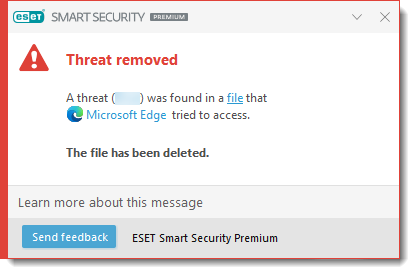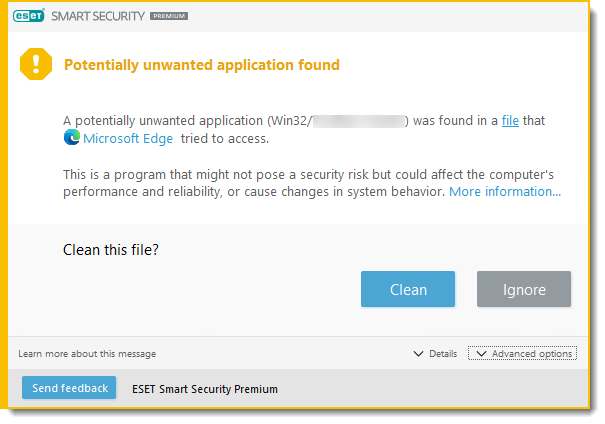Issue
- You have a suspicious file, suspicious website, potential false positive, or potential miscategorization by Parental Control or Web control that you would like to submit to ESET for analysis
- Submit a suspicious file / potential false positive file for analysis via email
- Submit a suspicious website / potential false positive website / potential website miscategorization
- Submit spam or spam false positive via email
- Submit a miscategorization of a website by the Parental control or Web control module
- Submit a fraudulent page (phishing)
- Submit samples using your ESET product
Solution
Submit a suspicious file / potential false positive file for analysis via email
Take screenshots of the threat detection notification you receive from your ESET product or any error messages or suspicious behavior that your computer is exhibiting.

Click the image to view larger in new window
Compress the files into a
.zipor.rararchive and password protect it with the password "infected".Create and send an email with the following information:
In the Subject line: Indicate if the attached file contains a suspected infection or a false positive (for example, use the subject
Suspected infectionor the subjectFalse positive).In the body of the email: Make a note of the password you set in step 1 and attach the
.zipor.rararchive as well as any screenshots. Include any background information where you found the sample and, if applicable, the Technical Support case number.In case the computer is already infected, include logs collected by ESET Log Collector.
Send the email to: samples@eset.com.
You are a software vendor, and ESET detects your app as a Potentially unwanted application (PUA)
Some "Threat found" or "Threat removed" detections are classified as PUA. If you think that an app was incorrectly detected as PUA, follow the steps below:

Click the image to view larger in new window
Take screenshots of the threat detection notification you receive from your ESET product.
Compress your application files into a
.zipor.rararchive and password protect it with the password "infected".Create and send an email with the following information:
- In the Subject line: Indicate that the attached file contains a false positive (for example, use the subject "PUA - False positive").
- In the body of the email: Make a note of the password you set in step 2 and attach the .zip or .rar archive as well as any screenshots. Include any background information where the sample is available and, if applicable, the Technical Support case number.
- Send the email to: samples@eset.com.
The issue is not resolved within three days, and the matter is urgent
Send a follow-up email message with the following information:
- The subject line of the email that you sent to samples@eset.com.
- Date and time of email.
- The email address you sent it From.
Submit a suspicious website / potential false-positive website / potential website miscategorization
Follow the appropriate instructions below, depending on the type of issue you want to submit:
Report a suspicious website or false-positive website via email
Create and send an email with the following information:
- In the Subject line: If you are reporting a blocked website that may contain potentially dangerous content, include
Domain whitelistfollowed by the blocked domain (such as www.blockeddomain.com). - In the body of the email: Include the URLs being blocked or that you found suspicious.
- Why do you think it is a false positive report. Provide as much information as possible about the source of the software, including the name of the developer, the name, and the application version.
- If you are reporting a blocked website, provide the complete URL that is blocked. Enclosing a screenshot of the notification about the blockage is recommended.
- Send the email to: samples@eset.com.
If the issue is not resolved within three days and the matter is urgent, send a follow-up email message with the following information:
- The subject line of the email that you sent to samples@eset.com.
- Date and time of email.
- The email address you sent it From.
Submit spam or spam false positives
- Email incorrectly marked as spam: If you received an email message classified as spam by your ESET product, and you do not recognize it as spam, send an email to nospam@eset.com with the original message as an attachment in .eml or .msg format.
- Undetected spam: If you received an email message that you classify as spam, but your ESET product did not classify it as spam, send an email to spam@eset.com with the original message as an attachment in
.emlor.msgformat.
Submit a miscategorization of a website by the Parental control or Web control module
Report a miscategorized URL or website here.
If you have already reported it and the website is still miscategorized, contact your local ESET partner for technical support.
- Click here to learn more about ESET Parental control.
- Click here to learn more about Web control in ESET Windows endpoint products.
Submit a fraudulent page (phishing)
If you believe you have deliberately and deceitfully discovered a similar page to another, complete this form to notify us.
Submit samples using your ESET product
If you prefer not to send an email, use the sample submission form in your ESET product. The process may differ depending on your ESET product GUI.
Click Tools → Quarantine, right-click the sample and click Submit sample for analysis.
Follow the in-product wizard to complete your submission.